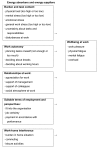Empowering employees with chronic diseases; development of an intervention aimed at job retention and design of a randomised controlled trial
- PMID: 18983652
- PMCID: PMC2614990
- DOI: 10.1186/1472-6963-8-224
Empowering employees with chronic diseases; development of an intervention aimed at job retention and design of a randomised controlled trial
Abstract
Background: Persons with a chronic disease are less often employed than healthy persons. If employed, many of them experience problems at work. Therefore, we developed a training programme aimed at job retention. The objective of this paper is to describe this intervention and to present the design of a study to evaluate its effectiveness. DEVELOPMENT AND DESCRIPTION OF INTERVENTION: A systematic review, a needs assessment and discussions with Dutch experts led to a pilot group training, tested in a pilot study. The evaluation resulted in the development of a seven-session group training combined with three individual counselling sessions. The training is based on an empowerment perspective that aims to help individuals enhance knowledge, skills and self-awareness. These advances are deemed necessary for problem solving in three stages: exploration and clarification of work related problems, communication at the workplace, and development and implementation of solutions. Seven themes are discussed and practised in the group sessions: 1) Consequences of a chronic disease in the workplace, 2) Insight into feelings and thoughts about having a chronic disease, 3) Communication in daily work situations, 4) Facilities for disabled employees and work disability legislation, 5) How to stand up for oneself, 6) A plan to solve problems, 7) Follow-up.
Methods: Participants are recruited via occupational health services, patient organisations, employers, and a yearly national conference on chronic diseases. They are eligible when they have a chronic physical medical condition, have a paid job, and experience problems at work. Workers on long-term, 100% sick leave that is expected to continue during the training are excluded. After filling in the baseline questionnaire, the participants are randomised to either the control or the intervention group. The control group will receive no care or care as usual. Post-test mail questionnaires will be sent after 4, 8, 12 and 24 months. Primary outcome measures are job retention, self efficacy, fatigue and work pleasure. Secondary outcome measures are work-related problems, sick leave, quality of life, acquired work accommodations, burnout, and several quality of work measures. A process evaluation will be conducted and satisfaction with the training, its components and the training methods will be assessed.
Discussion: Many employees with a chronic condition experience problems in performing tasks and in managing social relations at work. We developed an innovative intervention that addresses practical as well as psychosocial problems. The results of the study will be relevant for employees, employers, occupational health professionals and human resource professionals (HRM).
Trial registration: ISRCTN77240155.
References
-
- Dupré D, Karjalainen A. Statistics in focus: Employment of disabled people in Europe in 2002. Eurostat. 2003.
-
- Brink-Muinen A Van den, Spreeuwenberg P, Rijken PM. Kerngegevens Maatschappelijke situatie 2006, Nationaal Panel Chronisch zieken en Gehandicapten. Utrecht, NIVEL. 2007.
-
- Black C. Dame Carol Black's Review of the health of Britain's working age population. London, TSO; Working for a healthier tomorrow. 17-3-2008.
-
- Verstappen SM, Boonen A, Bijlsma JW, Buskens E, Verkleij H, Schenk Y, van Albada-Kuipers GA, Hofman DM, Jacobson JWG. Working status among Dutch patients with rheumatoid arthritis: work disability and working conditions. Rheumatology (Oxford) 2005;44:202–206. doi: 10.1093/rheumatology/keh400. - DOI - PubMed
Publication types
MeSH terms
Associated data
LinkOut - more resources
Full Text Sources
Medical
Research Materials


